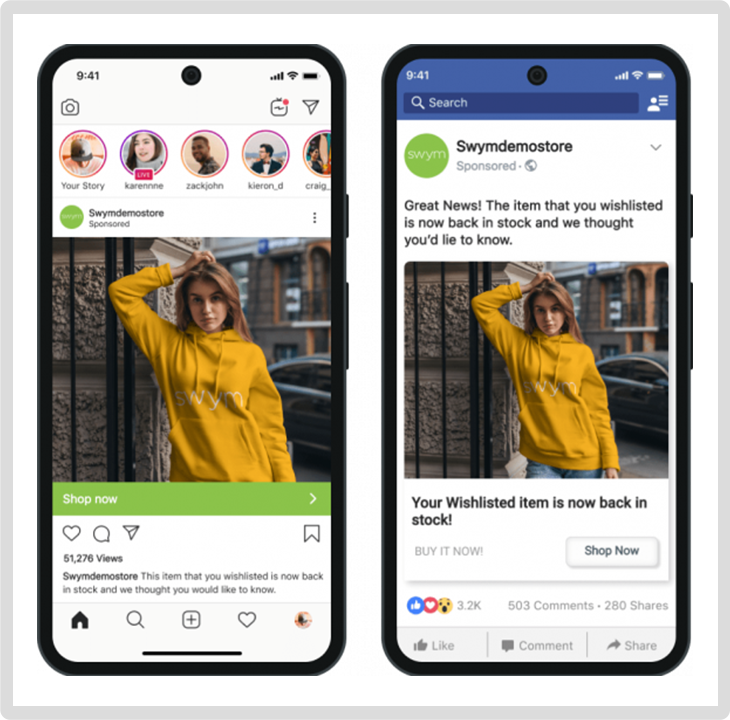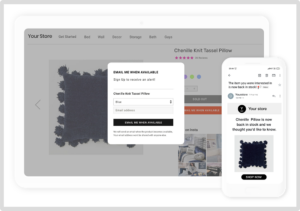89% of marketing specialists say that they use Facebook ads as of 2023. In most cases, you would question a statistic that indicates “almost everyone” is using a platform, but with Facebook and Instagram (that both fall under the Facebook-slash-Meta stable) it’s easy to believe. Most of us have seen every brand we’re familiar with advertise on Facebook.
Many brands start their Facebook advertising journey with static ads. Easy to launch, they represent what you may call the “low-hanging fruit” of the social advertising world. All you need to launch a static ad campaign on Facebook is a hero image that will form the background of your ad and a hooky headline with a compelling CTA to match. One ad. That’s all it takes. You can get your campaign up and running in minutes!
Dynamic ads are less of a breeze, but many argue that they are far more effective. Sure, you’ll need a whole catalog of images and countless different ads, and it’s also a slightly less straightforward process because ads are created based on customer data. But complexity aside, in this age of personalization, you can’t possibly ignore Facebook dynamic ads any longer.
Even if you don’t know what dynamic Facebook ads are, exactly, chances are you saw one the last time you were on Instagram or Facebook. You know, the one for those sunglasses (or other products) you added to your cart and haven’t bought yet?
As that example would suggest, dynamic Facebook ads are personalized to the ad recipient/ viewer’s behavior and characteristics. When we say behavior, we mean actions like wishlisting a product (which would indicate interest). Similarly, when we say characteristics, we’re referring to points like location. For instance, let’s say a customer in Florida wishlisted a skincare product, you might want to advertise the said product along with sunscreen when it’s summer in Florida.
The bottom line is this — Dynamic ads on Facebook and Instagram target specific viewers with specific information, contextualized to get their attention (and conversion, if you play your cards well). Moreover, new plugins have made it easier for you to segment your audience and automate the process of making your ads dynamic.
In this blog, we’ll show you how to make your ads dynamic. But before that, let’s look at hard proof that depicts exactly why you want to make your ads dynamic in the first place.
Case study: Seltzer Goods
About the company: Seltzer Goods creates and sells items like stationary, tote bags, puzzles and games.
Problem statement: Seltzer Goods typically worked with wholesalers, but 2020’s lockdowns meant an almost complete stop to that avenue of business. They went D2C overnight and their agency, InFlow, decided to set them up with dynamic Facebook and Instagram ads.
Here’s what they gained:
- 💰 9.68x return on ad spend (ROAS)
- 📈 785% increase in monthly revenue
- 💵 $4.87 cost per customer acquisition (CPA)
- 🔄 6.6% organic conversion rate
- 📊 183% increase in monthly organic traffic
- 🔍 931% increase in brand query and product searches
- 📈 200% increase in non-branded search query impressions
Here’s a summary of dynamic creative optimizations that made the above possible:
- Facebook Pixel to collect data on purchasers and site visitors for months before any ad campaign was launched. This helped gather customer data around key events such as ViewContent, AddToCart, and Purchase
- Custom audience targeting, starting with an interest-based audience ad set that was closely related to the puzzles Seltzer Goods sold.
- Lookalike audience targeting for three segments of visitors that took action on the site:
- Key page visitors
- AddToCart users
- Purchasers (once the seed audiences were sufficient)
How Facebook’s dynamic ads target your audience effectively
Dynamic ads on Facebook and Instagram work because they are responsive. They are fed to prospective buyers only after the buyer displays interest by committing predefined actions (that you get to choose because you know your audience best).
Moreover, the images and content can be programmed to respond to the sentiment expressed by the buyer by their action.
Let’s explore how this works.
Conversion events
Earlier, we talked about how Facebook dynamic ads are specific. This is where you set up some of the specifics. Conversion events are specific actions that prospective buyers perform on your e-commerce store or mobile app. Examples include making a purchase, adding an item to their cart, or asking to be notified when an item is restocked. If you go back to our Seltzer Goods example above, you will notice that viewing a product, adding it to cart, and making a purchase were their selected conversion events.
In this ad, the customer’s action of adding the product to wishlist was a conversion event
Invest time and thought in identifying these conversion events, as they create the foundation for your dynamic ads campaign to effectively target and optimize for the activities that matter most to you.
This step-by-step guide can help you get started.
Imagery and content
One of the best things about Facebook’s dynamic ads is that they give you the freedom to modify the photos, videos, headlines, and CTAs on your ads depending on whom the ad is being fed to.
To do this, you need to select Flexible for your ad format—now you will be able to choose up to 10 images and videos for your ad. Facebook dynamic ads’ delivery system will automatically identify what the ad viewer will see. They may see a single photo, or a video or a combination of these in a carousel. Learn how to go about this using this helpful resource.
Audience
Besides the conversion events method of choosing people to serve your ad to (which would be people who have interacted with your brand), you can also select new audiences to target via Facebook’s ad manager. Facebook lets you target new audiences in several different ways:
Detailed targeting
Here your dynamic ad will be served to people based on the following:
📰 Ads they respond to
🌐 Web pages they engage with
📊 Activities and interests displayed across Meta platforms
🧑🤝🧑 Demographics like age, gender, and location
📱 Mobile device in use and network connection speed
Find out more about detailed targeting here.
Custom audiences
Here your dynamic ad will be served to your own audience based on a variety of actions they take on your own e-store and app, and also on Meta’s platforms. In the Seltzer Goods, example above, they looked for audiences that looked for or showed interest in puzzles similar to theirs.
You carve out your custom audiences from the following (click links to find out exactly how):
Get more information about custom audiences here.
Lookalike audiences
This is a somewhat sure-shot way to target new customers by identifying people who show similar traits to your existing audience. You basically use one of the custom audiences that we talked about above to target people who behave similarly. Our brand in focus for this blog, Seltzer Goods, targetted audiences that shared traits with customers who had added their products to cart, purchased them, or at least spent time looking at them.
Learn how to go about it here.
11 dynamic creative optimizations that drive better results
🎯 Target the right audience
Like Seltzer Goods, you want to select the right conversion events and automatically target the correct audience for various creatives. Don’t restrict yourself to the ones on Seltzer’s list, however. Identify and test what might work for you and your goals. For example, you can choose the conversion event of “creates a customer account” and have such customers see dynamic creatives for your best-selling products.
Use Facebook dynamic ads in combination with Meta Pixel to evaluate ad performance. Meta Pixel creates a connection between your website and Meta’s platforms (Facebook and Instagram) to improve your campaign’s performance by monitoring actions that ad recipients take on your website in order for Meta’s own algorithms to target your ads better. Learn more about Meta Pixel here or get started with Meta Pixel here.
You can get even more targeted with your dynamic creative by zeroing in on customers who have shared more granular data with you, like, for example, when they add products to a wishlist or request a back-in-stock item. These actions tell you so much more about your customers because they show more than brand interest; they give you very specific information about what your customers like…in other words, you know just what to showcase and say in order to get them to stop in their tracks.
This helpful guide will help you to use the gold mine of data that comes from wishlist actions and restock notification actions made by your customers.
You can also improve audience targeting with Facebook Advantage+ audience. This feature puts the platform’s advanced AI and automation to work in defining your find your audience. Facebook Advantage+ identifies who to serve you dynamic creative to based on Meta Pixel data, prior ad interactions, and prior conversions.
Run targeted ads on Facebook and Instagram It’s easy with Swym’s data about customer patterns on your online store pages! Get the Swym Facebook Pixel Integration Now |
📲 Utilize a variety of call-to-action buttons
Determine the action you want users to take after viewing your dynamic creative. Experiment with different CTA buttons and observe how viewers respond to identify which ones work best. There’s no shortcut here, folks — different things work for different brands, during different campaigns, for different audiences, and at different times. Testing is your best bet.
📝 Keep text brief and clear
Keep It Short & Simple never goes out of style! Users scan through Facebook Feed and Stories at full speed, and the same goes for Instagram Feed, Stories, and Explore. Don’t you? Nobody’s doubling back to read an ad (well, there’s the occasional, award-winning exception, but don’t count on it). Ensure your text is concise and direct. Also, try not to jam the whole space provided with text. You’re better off leaving some white space than cramming in too much.
🎨Select good-looking assets
For your dynamic creative ad, you can use up to 10 assets. However, prioritize quality over quantity. It’s more effective to combine two or three strong assets than 10 less impactful ones. If you don’t have many image or video assets (which is unlikely, because you can just pull these from your product pages), start with multiple text assets.
🔍Highlight your image
Design ads with a clear focal point. Refer to Facebook’s own design tips to ace this. (You need to ace this; it’s literally the face of your ad)
🎞 Make images stand out with movement
Enhance your dynamic creative images with time-lapse, looping, and animations. There’s a ton of free apps that your designers can use, including Hyperlapse, Boomerang, Legend, Videoshop, Adobe Photoshop Express, and Adobe Spark.
🚫 Avoid overlaying text on images:
Instead, use the text, headline, and link description fields, or add a text overlay.
🎬 Feature engaging elements of your video early
Showcase your brand identity in the first few seconds, then reinforce it at the end. It might make sense to keep your video under 15 seconds, because never are people’s attention spans shorter than when they’re browsing for fun on social media.
🔈Design for sound-off; drive appeal with sound on
Many users watch videos with the sound off in public places. Use text, graphics, and captions to convey your story visually. Use auto-captioning tools or an SRT file for captions. But consider that some of the audience might be browsing with their sound on, so don’t forget about interesting, complementary, audience- and message-appropriate sound effects.
📱 Choose the optimal aspect ratio for the platform
People typically browse and view mobile content vertically. Choose a vertical aspect ratio for Facebook Feed and Stories, as well as Instagram Feed, Stories, and Explore.
Soar your conversions with Facebook dynamic ads
You can achieve what Seltzer Goods gained with Meta’s dynamic ads, and perhaps even more with the right dynamic creative optimizations. The bottom-line is that when you’re able to segment your audience, use data to grow your audience, and contextualize your creatives, you’re more likely to reach the right prospects, with a message that turns them from prospects to customers.





